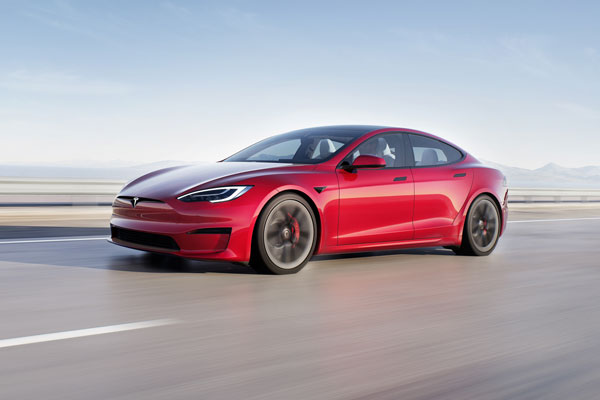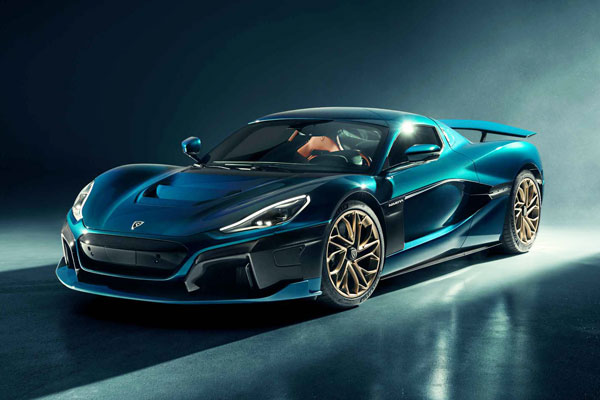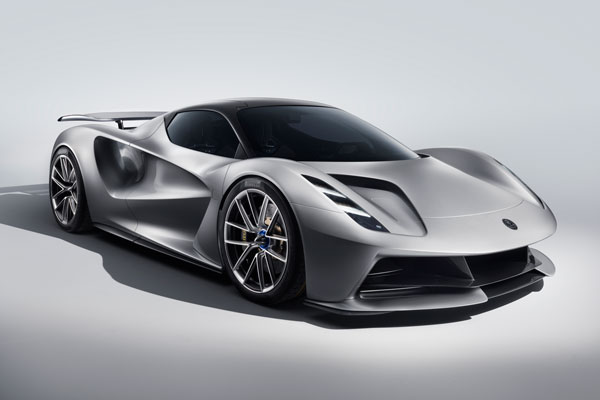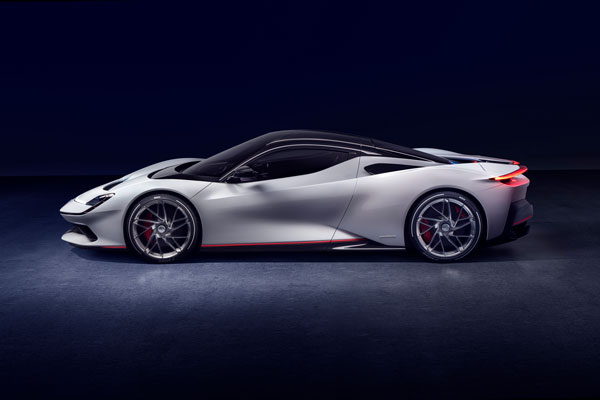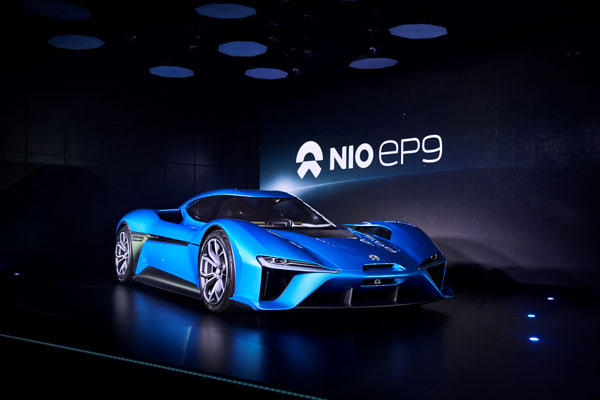Supercharged: The Rise of the Electric Supercar
In just a handful of years, the electric vehicle (EV) has moved from being a frown-inducing curiosity to being widely accepted as the future of transportation and mobility. Every day there are reports and announcements of new models offering greater range, bigger batteries, faster charging and so on, and even in Australia – to this point apparently indifferent to the technology – is beginning to embrace them, as can be seen from NSW’s recently unveiled Electric Vehicle Strategy.
When talking about EVs, it’s hard not to mention Tesla. It could be argued that the company kickstarted the current electric revolution (although GM did take a stab at the technology in the late ’90s with the well-regarded EV1), and while most of its vehicles are not sports cars, they are all swift with some being ludicrously quick.
Take the Model X, for example, a rather bulky-looking, mid-size SUV. According to the company’s website, you can order a version called the Plaid that will get you to 100km/h in 2.6 seconds. Top speed is 262km/h. That sort of performance in an SUV would be inconceivable before the electric vehicle era.
That’s the thing about EVs. Because electric motors can deliver 100 per cent of available torque immediately, they are incredibly quick off the mark. Give them enough juice and frightening acceleration and a top speed right up there with the very quickest as possible.
Of course, performance is not really what electric cars are all about. They are more about being efficient, cheap to run, and being free of those nasty tailpipe emissions. But, as we know, there is a thrill in being able to go fast and, in particular, in going faster than anyone else. And given the opportunities to do just that thanks to electric motors, a slew of incredibly potent electric supercars have emerged that offer some truly staggering performance and power numbers. Want 1000kW of grunt at your fingertips? Done. Keen to reach 100km/h in under two seconds? Done.
And with the recent appearance of cars such as the Rimac Nevera and the Tesla Model S Plaid, we thought that this month, we would take a look at a handful of the incredible all-electric supercars that are either available now or are slated to be so soon. They are amazing.
Tesla Model S Plaid
Tesla has been setting the benchmark for electric vehicles for some years now. In fact, you could argue that the company – and perhaps more particularly its enigmatic boss, Elon Musk – is responsible for igniting the EV revolution.
The company’s top model, the Model S, first appeared in 2012 and it was quick even back then. The P90D version could do the 0-100km/h sprint in 2.8 seconds and top out at 249km/h.
Fast forward to today and we find the Model S Plaid version, launched last month and an absolute rocket of a car.
Tesla says the Plaid has 760kW of grunt on tap, can reach 100km/h in about 2 seconds, tops out at 322km/h, and has a range of 652km.
For those with a mind for drag racing, it can cover the quarter mile in 9.23 seconds.
Underpinning these remarkable numbers is a tri-motor, all-wheel drive, platform. Those three independent motors (two at the back, one at the front) have carbon-sleeved motors which, the company says, allows for the car to ‘maintain peak power output all the way to top speed’.
While the Plaid is about performance, there are impressive numbers being created outside of that area too, with the car receiving improved supercharging functionality – the new battery pack can, Tesla says, be charged with 300km of range in 15 minutes using 250kW rapid charging technology.
On the inside, the redesigned cabin includes a yoke-style steering wheel, a whopping 17-inch infotainment display and a heap of other nice features, including a display for passengers in the rear; multi-device Bluetooth, wireless and USB-C charging for every passenger;
and a 22-speaker stereo system.
After nearly a decade of being in production, the Model S is a proven car, and the Plaid looks like crackingly good fun.
Rimac Nevera
The stunning Nevera, revealed in June, is a creation of the Croatia-based company Rimac.
The company has been at the centre of the electric ultra-high-performance action for some years and the Nevera is a production version of the company’s C_Two concept car that was unveiled three years ago.
Like the other vehicles on this list, the performance and power numbers that the Nevera boasts are staggering with 100km/h reached in 1.9 seconds and a top speed of 412km/h. There are four electric motors that drive each wheel individually and their combined output is a jaw-dropping 1427kW and 2360Nm. Energy comes from a 120kWh battery designed in-house by Rimac.
Aerodynamic elements complement the awesome power on tap and the Nevera’s monocoque includes a bonded carbon roof, integrated battery pack and rear carbon subframe.
There’s All-Wheel Torque Vectoring, regenerative braking, double-wishbone suspension with electronically controlled dampers, active ride height adjustment, and seven different driving modes are available, including a TRACK mode.
On the inside, the Nevera features a trio of high-definition screens, aluminium controls and switches and a connectivity system that delivers real-time data with telemetry and performance data able to be downloaded for later review.
There’s an interesting feature too called Driving Coach – which Rimac says can evaluate a driver’s performance and provide guidance to improve on-track performance. And thanks to a complex system of sensors, cameras and radars, the system can overlay selected race circuits in real-time, enabling drivers to ‘perfect their racing lines, braking and acceleration points and steering inputs’.
The company says that each Nevera will be unique thanks to the personalisation options that are available, and as well as bespoke options, the hypercar will be offered in editions called GT, Signature, or Timeless.
Lotus Evija
Lotus is a legendary name in automotive and is one of the handfuls of ‘traditional’ carmakers to pin their future on electric technology. In April, the company announced it would shift to be a designer and manufacturer of electric cars and platforms, going so far as to say it would make those platforms available to other manufacturers.
Lotus made its reputation building lightweight vehicles focused on brilliant handling and design, and that has been the aim with the Evija, although, in this case, the company can also boast one of the most powerful cars ever made.
Power output is an astonishing 1470kW (1972hp), torque is 1700 Nm, and 0-100km/h time is under three seconds. Acceleration from 0-200 km/h comes in less than six seconds, from 0-300 km/h in less than 10 seconds. Top speed is over 320km/h. Staggering stuff.
This potency comes via a 70kWh lithium-ion battery and four motors, one for each wheel, with a target power of 368kW (494hp) per motor. This system is, Lotus claims, the lightest, most energy-dense, electric power package ever fitted to a road car.
The Evija features a one-piece carbon fibre monocoque chassis, some inventive aerodynamic work to reduce drag and improve downforce, and the ability to accept an 800kW charge. Although charging units capable of delivering that amount of juice are not yet commercially available, when they are, Lotus says it will be possible to fully replenish the battery in just nine minutes.
Using existing charging technology – such as a 350kW unit – the Evija’s charge time will be 12 mins to 80 per cent and 18 mins to 100 per cent. The car’s range is 400km.
Pininfarina Battista
Italian carmakers do make nice-looking machines, and the Pininfarina Battista is a fine example of the beautiful cars they can deliver. More often than not, the graceful sports cars they design are complemented by some top-quality engineering under the body and this one certainly has that – delivering performance that perfectly matches the sleek form.
As it happens, Automobili Pininfarina – which obviously has links to the famed Pininfarina design company – developed the Battista with input from technical partner Rimac (manufacturer of the Nevera on Page 28) that provided the battery and powertrain system.
What they created is a hypercar Pininfarina says ‘will be the most powerful car ever designed and built in Italy’, and underneath that carbon fibre body is a carbon fibre monocoque chassis, a 120kWh battery pack and four motors independently distributing torque and power to each wheel.
How much power? A whopping 1417kW and 2300Nm that delivers acceleration of 0 to 100 km/h in less than two seconds,
to 300 km/h in less than 12 seconds and a top speed of up to 350 km/h.
Range is a claimed 450km and fast-charging functionality is a given, of course.
Like other electric supercars, the Battista’s digital technology will allow drivers to electronically adjust the driving experience through multiple modes tuned to a range of driving scenarios and delivers a luxurious interior full of tasty trims in aluminium, carbon fibre and leather.
Just 150 units of the Battista are to be made.
Aspark Owl
This is the Aspark Owl, a creation of Japanese engineering company Aspark, and a car that made its market debut earlier this year and is now on sale in North America and Europe. The Middle East and Asia markets are on the company’s radar for the car, and just 50 are to be built in the initial production run.
So, what will buyers be getting?
Well, according to Aspark, they’ll be able to get their hands on the fastest accelerating car in the world with 100km/h reached in somewhere around 1.7 seconds. It’s no slouch at the far end of the speed dial either, with a top speed of 400km/h.
This performance comes via four electric motors churning out 1480kW of power and overall torque of 2000Nm; a 69kWh battery pack; an all-wheel torque vectoring system; and a body, chassis and plenty of components made from carbon fibre materials. Range for the Owl 450km.
At just 99cm tall, the Owl might be tricky to get in and out of, but it looks fun and no doubt will be a blast to drive, and there are some features designed to allow the driver to tailor it to their taste. For example, there are four drive modes – sport-dynamic, rain-snow, city-comfort, high boost. An active rear wing is designed to operate automatically, and also manually. It will automatically activate at 150km/h to increase downforce. There’s also a double-wishbone hydraulic suspension system that allows the driver to adjust the ride height between 80mm and 160mm.
Nio EP9
Nio is one of China’s leading EV companies and came storming out of the gate back in 2016 with this, the EP9.
A true supercar, the EP9 started life with a bang, breaking the lap record for EVs at the Nurburgring in Germany and the Circuit Paul Ricard in France. And that is no surprise. Underneath the tremendously sleek and aerodynamic carbon fibre body is a carbon fibre chassis and there are four high-performance 250kW motors – each with its own gearbox – with one at each wheel.
With 1000kW and 1480Nm available, the EP9 can get to 100km/h in 2.7 seconds, and reach a top speed of 313km/h.
There’s all-wheel-drive (obviously); active suspension; torque vectoring; and active aerodynamics, with the massive three-position rear wing, front splitter, and underbody diffuser that runs the length of the car giving the EP9 huge amounts of downforce – twice that of an F1 car apparently – and 3G cornering capability.
The battery system is pretty clever. There are two battery packs – one on each side of the body between the front and rear wheels – and they can be charged in 45 minutes or be changed for a fresh pack in just 8 minutes.
On the inside, the design is spartan, reflecting that the EP9 was designed with track work in mind. Four screens are used to display various pieces of information, from performance data such as speed and lap time through to a track map and even driver and passenger heart rate.
There’s some real pedigree behind the EP9 – with Nio taking part in the Formula E electric racing car championship since its inception in 2014 – so it’s no wonder the car is a record-breaker.
Lucid Air
The Lucid Air, like the Tesla Model S Plaid, is one of those electric vehicles that really highlights how powerful electric powertrains can be. It is a quite beautiful sedan, and that is nice, but a four-door sedan does not look like a supercar, no matter how stylish.
Underneath that very nice exterior though, and it’s a different matter. Like the other, sleeker supercars on this list, the Lucid Air packs a massive punch thanks to the electric powertrain, and in the top trim model – the Dream Edition – will come out with 805kW thanks to a dual-motor, all-wheel drive architecture. 0-100km/h can be reached in about 2.5 seconds and Lucid claims a quarter-mile time as quick as 9.9 seconds. Top speed is reportedly 270km/h.
Lucid also claims that the Air will be the fastest charging EV, with the capability to charge at rates of up to 20 miles (32km) per minute when connected to a DC fast charging network. It has a 113kWh battery pack and a 900-volt electrical architecture. The Grand Touring version of the Air will, the company claims, be able to travel 830km on a single charge.
The Lucid Air is a luxury car really.
It’s packed with all the latest and greatest infotainment and safety tech – including a 34-inch curved Glass Cockpit 5k display – and the
Dream Edition will be available with a trim package that includes full Nappa leather throughout and silvered Eucalyptus wood accents. It will also feature a unique 21-inch ‘AeroDream’ wheel design.
Lightning fast and luxurious as well. Sounds good to us.
Source: Motor Trader e-Magazine (July 2021)
12 July 2021




